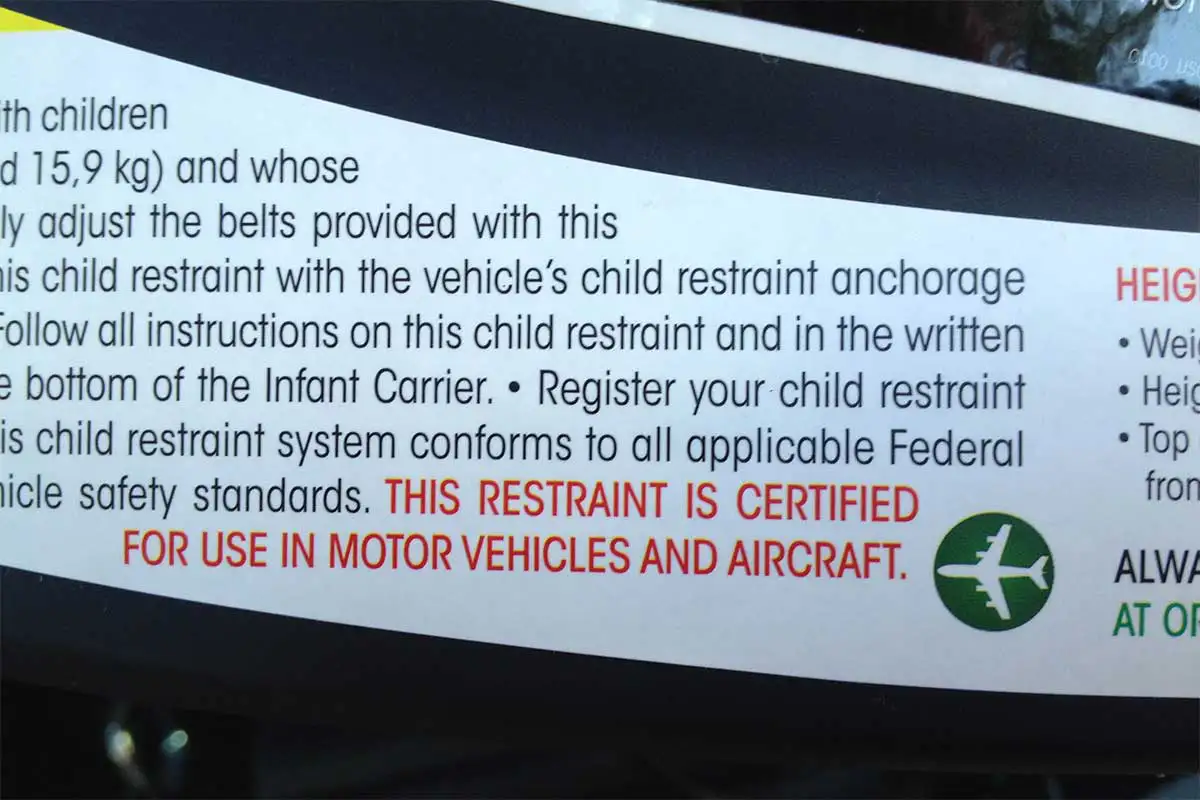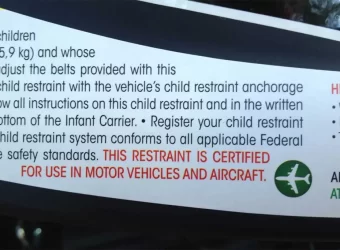Flying with a Child Who Lacks Trunk Support

Flying with a child who lacks trunk support may appear impossible at first glance. Although the process is manageable with infants, as children grow it can become more difficult. That said, with a bit of research, preparation and education, flying can become a reality for toddlers, teens and even young adults who lack trunk support. With that in mind, here’s what you need to know to have a safe and comfortable flight.
Infants
Infants are pretty easy, as far as air travel is concerned. Basically you just need to bring along a Federal Aviation Association (FAA) approved Child Restraint System (CRS) – more commonly known as a car seat. It can be a forward or rear facing model, but it must have two FAA approved labels on it. One label must include the text, “This child restraint system conforms to all applicable federal motor vehicle safety standards”. The other label must include (in red) the text “This restraint is certified for use in motor vehicles and aircraft.” Alternatively, it’s acceptable to have the two labels merged into one if all the appropriate text is included.
It’s important to remember that under FAA regulations, no carrier may prohibit a child (any passenger under 18) from using an approved CRS as long as they have purchased a seat, fall within the manufacturer’s height and weight limits for the CRS, and are accompanied by a parent or guardian.
Toddlers
As a child that lacks trunk support grows, parents have to explore other options. The FAA limits what type of seating devices may be brought aboard the aircraft, but many parents use neck pillows, towels and blankets to help support their children. Seating the child next to the window sometimes helps too, as they can lean on it for support. That said, you have to be careful with what you bring aboard, because unless it’s FAA-approved, any homemade device that straps to the seat or is too big and bulky will usually get the boot.
The CARES Harness (amsafe.com/kidsflysafe-com/) may be an option for some children. This FAA-approved harness straps to the seat and can be used on children over one year old who weight between 22 and 44 pounds and can sit in their own seat.
Another option is buy a first-class seat and physically help help the child maintain his balance during takeoff and landing. After that he can recline, and because of the extra room in first-class, the seat goes back further.
A number of companies also offer FAA-approved CRS for toddlers. They all have height and weight limits, so it’s best to check the company’s website carefully for these restrictions. It’s also important to remember that in order to take any CRS on an airplane, it must be labeled that it is FAA approved for use on an aircraft. If a CRS does not have this label, it will not be accepted, even if the manufacturer says it’s approved. Labeling is extremely important.
Older Children — European Carriers
Once a child gets older and gains more weight, flying with a child who lacks trunk support can be more difficult. That said, if you plan to travel throughout Europe, you may be able to use the Meru Travel Chair (merushop.org/product/travelchair-enabling-disabled-children-to-fly/).
This seating device is designed for children from 3 to 11 years old, who weight up to 35 kg (77 pounds). It was developed with the support of the UK Civil Aviation Authority and families with disabled children. The chair fits into an airplane seat and has an adjustable headrest, footrest and a body harness that allows for various levels of support. It should be noted that the Meru Travel Chair is designed for an upright airline seat, and once installed the seat cannot recline.
The Meru Travel Chair is approved by the European Aviation Safety Agency (EASA), but it is not approved by the FAA. And if you do plan to use the Meru Travel Chair, it’s essential to give the airline at least 48 hours notice or more, to make sure that the aircraft can accommodate the seating device.
Older Children — US Carriers
In the US, if you want to use a Meru Travel Chair or any other non-approved CRS, or if your child exceeds the height and weight limits for an approved CRS, you need to file for an FAA exemption.
You will need to file a petition for exemption from section 121.311(b) of Title 14, Code of Federal Regulations (www.ecfr.gov/current/title-14/chapter-I/subchapter-G/part-121/subpart-K/section-121.311). This is the section that specifies that “each child aboard an aircraft operated under part 121 must occupy an approved seat with a separate safety belt secured about him or her, and must not exceed the specified weight limit for the restraint system.”
Many exemptions have already been granted for children who lack trunk support. With that in mind, sometimes it helps to look at these granted exemptions to know how to correctly word a request for accommodations. Two well written examples are #7831 (Joseph Castasus) and #9834 (Avery Ottenbreit). Although they are older, many people have successfully patterned their petitions after them.
If your exemption is granted, it’s good for five years and it’s valid on all US airlines. Most exemptions also carry over into adulthood if a child turns 18 before it expires. After a child reaches adulthood, they need to file for an exemption on their own behalf.
The FAA recommends filing an exemption at least 120 days prior to your travel dates; however you’re not required to hold any reservations in order to file for an exemption. There’s no cost to file for an exemption, so it’s worth a shot if you plan on flying with a child who lacks trunk support. For more information about how to file an exemption, visit www.faa.gov/regulations_policies/rulemaking/petition/.
Before You Fly
There are also a few things you need to know about accessible air travel before you head to the airport. First and foremost, know your rights (emerginghorizons.com/the-disabled-air-travelers-bill-of-rights/) under the Air Carrier Access Act. These rules apply to US airlines and to foreign airlines on flights to and from the US. Learn the law, so you know what to expect.
It’s also advisable to check with the airline in advance if you are traveling with a toddler or an older child who uses a CRS, as some small aircraft may not be able to accommodate a larger CRS. Additionally, some seating restrictions — such as no exit row seating — may apply to passengers who travel with a CRS. And it’s always a good idea to give the airline plenty advance notice if you are traveling with an exemption, so there are no surprises or delays at the airport.
Regulations about flying with a CRS vary around the world. Some are more restrictive, while others are more liberal. Copious research is needed for international travel. Never assume that policies will be the same overseas, as they are in the US.
Finally, if you experience an issues about your CRS on a US airline or on flights to and from the US, contact the Complaints Resolution Official (emerginghorizons.com/flying-with-a-wheelchair-remember-the-cro/). This airline employee is specifically trained to resolved access-related issues, and all covered airlines must have a CRO available by phone or in person. The CRO can be your best ally when you run into an access problem.

